Technical Tips
2500M/3000M Overheating?
Many people, when their TVR overheats, think they should swap in a radiator from a Corvette or a Peterbuilt.
There is no reason to do this, unless you really just can't stand carrying a spare tire.
There so many things that can cause overheating in a thirty year old car, and the newest 2500Ms were built
over thiry years ago. This means your car has been able to buy drinks in bars for nine years.
It is older than most
of the people voting in the next election, and more intelligent too.
The TVR 2500M uses, of course, the Triumph Tr6 engine. A little background on this is in order.
Previously Triumph had developed a 'new' small car engine code named 'SC'. This was a 948cc four cylinder
overhead valve engine. Over the years Triumph stretched this motor to 1147cc and then to 1296cc.
Then they added two more cylinders to make 1600cc and 2000cc engines.
So when Truimph wanted more power for the Tr4, They didn't add two more cylinders to the Tr4's
2138cc four cylinder engine, oh, no, they took the 2000cc six and stretched it some more - to 2498cc.
Mind you, in all this stretching, some parts of the engine did not get stretched. Like the water passages
in the block and head, or the ports where said passages connect to the water pump.
This is a major choke point for cooling the Tr6 engine no matter what car it is propelling.
The fact that the water pump is not a sterling piece of hydrodynamic design does not help matters.
I am going to use Fahrenheit degrees even though my car came with a Centigrade gauge.
BTW an international
committee of busybodies decided to rename centigrade to Celsius;
Celsius invented Centigrade, and if he wanted to name it after himself,
he would have done so. Screw the committee.
Causes of Overheating
Some of the following items may see obvious, but it is easy to over look something
when you are running around trying to buy a radiator out of R.M.S. Queen Mary.
-
Temperature Gauge
-
How do you know the car is overheating? Because the gauge says so?
You need to test your gauge. The best way is by using a gauge that is known to be accurate,
such as a thermocouple thermometer that has been calibrated against boiling water. Those neato
laser thermomters may work, but you must calibrate them because they are plus/minus 20 degrees.
So one of them may claim your car is doing 210F when it is really doing 190F.
If you wish to replace the sender, you need to find a Vaxhaul sender, as the gauge used by TVR does not
us a Truimph sender unit. I found four of these little jewels. When I tested them I found that
not one of them gave correct readings. I gave up and got a Smiths mechanical gauge.
-
Thermostat
-
Physically, the thermostat is the same size and type as used by the small block Chevy and 302 Ford.
However, these engines use very powerfull water pumps, unlike the Tr6, so you want to use only those
thermostats that provide maximum flow. Use only
Stant and Wahler units.
I have tested them and they are the best flowing units I have encountered
since 1983. I
have also tested Delco and Mopar units, they have poor flow. Don't use them.
For normal, use I recommend a 180° thermostat. For very hot climates use 160°
and for cold use 195°. (The heater works MUCH better with a 195° thermostat.)
Interestingly, Stant does not recomend a 195° thermostat for the Tr6, because
they think it
was fitted with a 7 psi radiator cap.
If you want to run without a thermostat, don't. Use a thermostat blanking sleeve;
to make one, take a thermostat and rip out the valve disk and use it that way or use one of
the Mr Gasket blanking sleeves. The way many cars including the Tr6 work, is
the pump blasts water up at the thermostat, and the water bounces off the thermostat
and into the head. When the thermostat valve opens, some of the water is allowed
to escape to the radiator. If there is no thermostat, all of the water goes to
the radiator and none into the head.
Triumph recommended 180° F (80° C) for 'normal climates' and
190° F (88° C) for 'cold climates'.
| High Flow Thermostats |
|---|
| Brand & Type
| Part Number
|
|
| 160° F
| 180° F
| 190° F
| 195° F
|
| Stant Superstat
| 45356
| 45358
|
| 45359
|
| Stant Regular
| 13356
| 13358
|
| 13359
|
| Wahler
| 3004.74
| 3004.82
| 3004.88
|
|
-
Radiator cap
-
The radiator cap is actually on what is called the 'header tank'.
The Tr6 and TVR where built with 13 psi radiator caps. This works adequately
with Ethylene glycol antifreeze. Around the year 2000 most antifreezes were reformulated
using propylene glycol and other chemicals. This seems to causes higher presures in the cooling system;
Each brand seems to have a different
formulation and therefore differing pressure. I now recommend using at least a 16 psi cap.
I am only going to list Lev-R-Vent stype caps because they release the pressure
before you unlock them (so the hot water can not burst out and burn you).
| Radiator Caps |
|---|
|
Brand & Type
| Model
| Part Numbers
| Pressure
|
| Stant Lev-R-Vent
| 328
| 10328,11328
| 7 psi Not recommended
with modern anti-freeze.
|
| Stant Lev-R-Vent
| 329
| 10329,11329
| 13 psi
|
|
Stant Lev-R-Vent
|
330
| 10330,11330
|
16 psi
|
|
Stant Lev-R-Vent
|
334
| 10334,11334
|
18 psi
|
|
Stant Lev-R-Vent
|
335
| 10335,11335
|
20 psi
|
Stant Lev-R-Vent
Racing Radiator Cap
| 381
| 10381 | 18 - 22 psi
Not for use on passenger cars.
See warning on Stant web page.
|
Stant Lev-R-Vent
Racing Radiator Cap
| 382
| 10382 | 21 - 25 psi
Not for use on passenger cars.
See warning on Stant web page.
|
Stant Lev-R-Vent
Performance Radiator Cap
| 330
| 19330,28330
| 16 psi
25 to 50% narrower variation
in range of pressure
|
-
Filler neck
-
When TVR built the M series they seem to have used whatever filler necks were
available. This means some TVRs are fitted with Austin-Healey or MGC filler necks
which have different sizes than the current industry standard of 3/4".
In case you are wondering, Austin-Healey and MGC caps are no longer available.
Have a radiator shop change the neck to one that fits the Stant 330 or compatible
cap.
-
Electric fans
-
Are both electric fans running? Do you have the later style 10 bladed fans? Have
you rewired them using 10 or 12 gauge wire running directly from the positive
terminal of the battery through a relay to the fans, and replace the ground
circuit with fresh wires too? If you must replace the Smiths motors and Kenlow
fans, you could switch to SPAL 7.5" fans.
When the car starts to run hot, does the otter switch turn on the fans? If
not, do you turn them on with a manual override switch? If you have replaced
your fans with aftermarket units, you may not be able to hear them run or
not run, as the case may be.
-
Engine idle
-
In very hot weather, the temperature compensators on the Stromberg carbs drop
the engine idle down to 200 rpm. Really. At this speed the water pump cannot
pump enough water to keep the engine cool no matter what radiator you use.
You can use the throttle to idle around 1500 rpm, which will solve the problem.
-
Fuel mixture
-
I am told that the Tr6 engine will run with the mixture set so lean that the
car will get 35mpg. A mixture this lean will cause the car to overheat.
-
Block and head
-
Are the cooling passages clogged with minerals? Do you have a cracked block, head or a blown head gasket?
Exhaust gases leaking into the cooling system will cause overheating.
-
Hoses
-
Are your hoses collapsed or kinked?
-
Radiator core
-
2500M/3000M: Have you had the core replaced with the latest louvered core?
3000M/Taimar/3000S (large radiator): Some cars were shipped with single core
radiators, you should have it upgraded to the latest core stype with two or three
rows of tubes.
-
Fan shroud
-
|
Do you have the 1977 model fan shroud with ducts all of the air leaving the
radiator to the engine mounted fan. This part provides a big improvement all
by it self. Note that the fan shroud is not illustrated in the TVR Parts Manual.
The shroud was developed by Gerry Sagerman's TVR Cars Of America and the moulds
sent to the factory. The moulds have since disapeared.
| 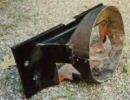
|
Stock M Series Cooling Fans
The early M series used two electric cooling fans in the States and one fan in the UK.
The fans were white, had six blades, and were made by Kenlowe Accessories, pn: KLM 1005.
The UK cars switched to a black ten bladed Kenlowe
fan, which pushed much more air than the white ones.
Replacing the six blade fans with
ten blade units puts much more air through the radiator without having to modify
the car to use different electric fans.
 | 
|
| Early fan | Later fan
|
| 15318 | 15322
|
The late MGB used two yellow four bladed
fans, I have used them too, but they don't fit too well and the black Kenlow fans push more
air and vibrate less.
Updated 10 June 2000
M Series Radiator Mounting
The M series cars used two styles of radiator: the "large" radiator, used on most Taimar
and 3000S (and it seems, some 3000Ms) which mounted behind the spare tire and the "small" radiator used on all other Ms
and all the Turbos which fit under the spare tire. ("Large" and "small" seem to be factory
terms.) The "small" radiator is mounted with two pins on the bottom which fit into holes on
the frame and a bracket on top with a bolt hole that matches a bracket on an upper frame tube.
Most people clamp these brackets together as the factory intended. When driving through pot holes
(a rarity in England) the frame flexes from side to side - the very stiff radiator, pinned
between the two pins and the bracket resists this flexing and sometimes snaps a solder joint.
Throw the bolt away to prevent this problem. Between the pins and hoses
the radiator isn't going anywhere.
Thanks to Pietro Abate for the tip about 3000Ms using the large radiatior.
30 October 2002
Improved Small Radiator
I put an alloy radiator in the Taimar over the summer, obtained via
Ian Bannister. One of his mods is to use a screw-in otter switch, in
this case the rad was built with a threaded hole, but alternatively
you can braze a nut on the outside of the radiator.
My otter switch is a Quinton Hazell item, part no QHNXEFS14 from
Partco at \A39.38, I think it is a Ford unit. There are several
different ones set to activate the fans at different temperatures.
It is the short, wide radiator underneath the spare tire. The
radiator is an exact copy of the original but has a slightly larger
capacity. The twin Honda Blackbird fans will probably do a good job,
except that I haven't managed to get it hot enough for them to come
on yet!
Oliver
31 December 2002
Replacing The Large Radiator
When replacing the 'rear' [large] radiator, always check that it has 2 or more cores.
The 2000cc Capri radiator looks the same, but only has one core. I found this out when I went to
have my radiator repaired, and the guy asked what engine it was from. When I said a 3000cc V6 Essex,
he told me that the single core would never keep the engine cool. This was true as I had had very bad
overheating problems. Put a dual core in, and it now keeps cool OK.
Pietro Abate
1 November 2002
| 2500M Cooling Systems |
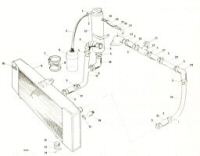
| 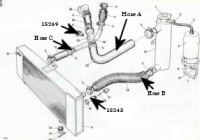
| 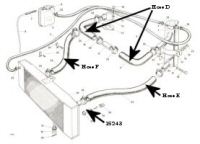
| 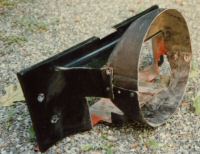
|
| The early 2500M cooling system, possibly up to chassis 2592.
There may not be any of these in North America.
| The 1974 2500M cooling system. The engine was not
equipped with a air pump for US emissions.
| Later 2500M. The engine was equipped with an air pump for Federal emmissions in the US.
| The fan shroud for the 1977 and later 2500M.
|
Parts List
- Part 10115
- Coolant reservoir, early (header tank)
- Part 10117
- Coolant reservoir, 1974+ (header tank) The 1974 cars (and possibly other years) were equipped
with many different length filler necks and caps. If you are having trouble with boiling over,
make sure your car is equiped with a neck that matches the only currently available caps. This is
the same size as a Tr6. (Feb 25, 2007)
- Part 10119
- Coolant reservoir, later cars (header tank)
- Part 15232
- Bleed valve. Used to bleed gases trapped in the radiator. This is a standard plumbing fitting
available in the United States (perhaps in Canada, too). The thread is 1/8" NPT. Imperial and American pipe
threads are, surprisingly, the same. Pity Britain switched to the Metric system.
In later cars this was replaced by a bleed hose which snakes up to the header tank.
I personally prefer the bleed valve because once the gas has been bled, more gas should not appear. If it
does this indcates a problem such as a leaking head gasket. I have to admit that minor head gasket leaks are
probably common and unnoticed by people who do not bleed their radiators periodically.
- Part 15269
- 'Thermo-vacuum switch' was fitted to the Tr6 ostensibly for emissions.
It has nothing to do with emissions.
The reality is much more sinister. When under bonnet temperatures become too high, as in sitting
in a traffic jam on the Washington Beltway on a June Saturday afternoon,
the elaborate temperature compensators mounted on the carburetters would go wonky and
drop the engine to about 200 rpm. At this speed the water pump is unable to circulate enough
water, and the car would overheat. As the coolant temperature rises,
the thermo-vacuum switch providentially leans out the mixture, causing the engine to speed up,
hopefully enough so that the car did not overheat. Apparently the accountants prefered to
pay for a whole lot of vacuum pipes and switches which broke and pissed off the customers rather
than paying once for a new water pump casting which could actually move water, or
carburetters that worked correctly.
- Part 15243
-
'Otter' switch, is supposed to activate the electric fans when coolant temperature
became too high. This switch was also used in several other cars such as the 1979-1980 MGB.
The otter switch is so reliable that almost every TVR equipped with one is also fitted with a manual
override switch to operate the fans when Mr Otter takes a powder.
The otter switch is retained by an elegantly shaped gasket. Occasionally this gasket will let go, blasting
Mr Otter into the street, leaving a 1" hole in the radiator. The gasket will of course have disappeared.
Secure Mr Otter and his gasket with a large tie wrap or stout wire to prevent this.
- Hose A
-
|
The hose from the thermostat cover to the header tank for the 1974 cars.
This replaces two hoses, an adaptor and the thermo-switch.
When trimmed to length, Dayco hose part no. 71128 is a near perfect replacement.
Hayden reports that this hose is from the 1982 BUICK SKYLARK L4 2.5 liter upper hose (with A/C).
If you can't find that, a 1¼" dia. flex hose 17½" long will work.
|
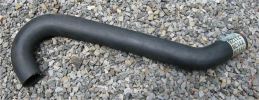
|
- Hose B
-
Header tank to radiator: 1 ¼" diameter 20 inches long (21 inches if you have a fan shroud).
- Hose C 1974+
-
Radiator to water pump: 1 ¼" diameter 22 inches long (23 inches with fan shroud). A molded hose was
available for a few years.
- Hose D 1976+
- Two of these hoses were used with a coupling between to construct the hose from
the thermostat to header tank.
- Hose E 1976+
- Header tank to radiator. This is the later moulded version of hose B; it depends on the length of the pipe
from the bottom of the header tank.
- Bottle A
- Plastic overflow bottle. The donor car is unknown. Most people
use a Tr-6 bottle and bracket.
| 3000M, 3000S, Taimar and Turbo Cooling Systems |
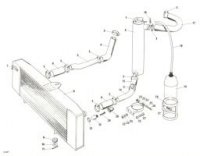
| 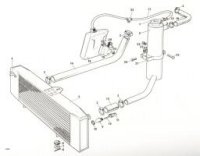
| 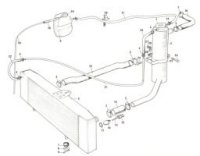
| 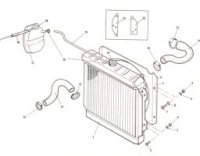
|
|
3000M up to 2617.
|
3000M from 2618 to 3038.
|
3000M 3039 to 4569 and Taimar to 4424 and Convertible to 4583.
|
3000M from 4570 Taimar from 4425 Convertible from 4584.
|
Notes
Fan and cooling system illustrations from "M Series Spare Parts Catalogue Taimar - Turbo Convertible 1972 - 1980"
available from the TVRCCNA.
Corrections and tips should be sent to CRC
Next
Previous
Contents
Home
Last updated on January 13, 2008.











